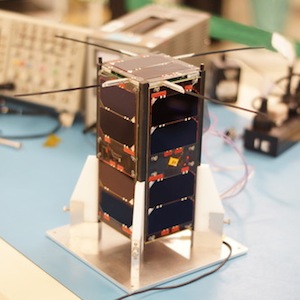Launches in April 2013
| Date | Launching | Launch Vehicle – site |
| delayed April 17, 2013 |
Phonesat-1 and -2 | Antares-110 – Wallops Flight Facility |
| Launched April 19, 2013 |
BeeSAT 2 and 3 | Soyuz-2.1a – Baikonur, Kazakhstan |
| Launched April 19, 2013 |
OSSI-1 | Soyuz-2.1a – Baikonur, Kazakhstan |
| Launched April 19, 2013 |
SOMP | Soyuz-2.1a – Baikonur, Kazakhstan |
| delayed April 20, 2013 |
Phonesat-1 and -2 | Antares-110 – Wallops Flight Facility |
| Launched April 21, 2013 |
Phonesat-1 and -2 | Antares-110 – Wallops Flight Facility |
| Launched April 26, 2013 |
CubeBug-1 | CZ-2D from the Jiuquan Space Center |
| Launched April 26, 2013 |
TURKSAT-3USAT | CZ-2D from the Jiuquan Space Center |
Phonesats
Downlink
437.425 MHz
Hello CubeSats and Amateur Radio Operators
The very first PhoneSat’s will be launching aboard the Antares on April 17th at 2100 GMT (launch window to April 19th possibly further). We have manifested 2x PhoneSat 1.0 and 1x PhoneSat 2.0 Beta.
Our orbit is very low (270km x 300km 51.6deg) and we’ll only be up there for 2 weeks! So we’re looking for as many people as possible to help with tracking our satellites. If any of you are interested in tracking the satellite please let myself (+the cc’d team) know – your help will be greatly appreciated!
All three satellites will be transmitting on 437.425MHz and TLE’s + more info can be found at www.phonesat.org . Feel free to tune-in and submit packets via www.phonesat.org.
The Cubesats are launched, deployed and active.

 CubeBug-1 is the first technology demonstration mission for a new cubesat platform design (mechanics, hardware and software) intended to be released as Open Source and Open Hardware for its use in Amateur projects, University projects and research labs. This project is sponsored by the Argentinian Ministry of Science, Technology and Productive Innovation, INVAP S.E., Satellogic S.A., and Radio Club Bariloche.
CubeBug-1 is the first technology demonstration mission for a new cubesat platform design (mechanics, hardware and software) intended to be released as Open Source and Open Hardware for its use in Amateur projects, University projects and research labs. This project is sponsored by the Argentinian Ministry of Science, Technology and Productive Innovation, INVAP S.E., Satellogic S.A., and Radio Club Bariloche.